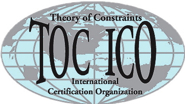Throughput Accounting Global Measures
Throughput Accounting lifts profit performance by enabling better management decisions based on 3 key monetary metrics Throughput, Investment (inventory) and Operating Expense.
Throughput (T) is the rate at which the system makes money through sales.
T = S - RM. S = Net Sales & RM = Raw Materials and any directly variable expense
Note: There is no T unless there is a sale. The only money entering the system comes from customers. Producing product that sits in storage warehouse or on the factory floor is Investment.
Investment (I) is the money tied up in the system required to produce the Throughput.
This is money tied up with inventory (raw material, work in progress, finished goods), machinery, buildings and other assets and liabilities. Inventory is measured at raw material cost at each stage without any additional overhead cost allocations.
Operating Expense (OE) is the money the system spends in generating the "Goal Units" or Throughput.
Operating expenses are viewed as relatively constant (such as salaries and wages, insurance, rent etc) over a relevant time period. Expenses that vary directly with sales volume (such as raw material costs, commissions, freight) are considered to be totally variable costs, not OE.
How do these Global measures help better management decisions?
Most would agree that the 3 primary measures of business health are Profit, Return on Investment (ROI) and Cash Flow. If we have good Profit, ROI and Cash Flow we can say our business is doing well. So how can the Throughput Accounting Global measures help us achieve the primary measures of success?
The global measures of T, I and OE can all be used to derive these primary measures of success as follows:
-
Profit = T-OE
-
ROI = T-OE/I
-
Cash Flow = ^(T-OE) - ^I The symbol ^ represents change.
Other measures
Productivity = T/OE, Inventory Turns = T/I
This means that for increased profit, ROI and Cash Flow we must:-
-
Increase Throughput
-
Decrease Investment
-
Decrease Operating Expense
So, to strive for the Goal every decision a company makes should be tested against these criteria:
Does it increase Throughput and how?
Does it reduce Investment and how?
Does it reduce operating Expenses and how?
Some decisions may incur additional Investment or Operating Expenses. As the measures are relative then it is a good decision if the relative increase in T is greater than the relative increase in I or OE.
The 4th metricThe true power of these Global measures (T, I and OE) becomes apparent when applied at the Constraint to determine the velocity of throughput for the system.
T/CU is Throughput per Constraint unit. This is the key to maximising profitability. When we look at money flow we are looking at the rate by which money flows through the constraint. For every minute of constraint time we want to maximise the $ Throughput through the constraint. A dollar lost at the constraint is a dollar lost to the whole system.
By understanding how to exploit the scarce capacity of the constraint we can use these measures to maximise profitability, ROI and cash flow.
Contact us now for information on our Throughput Accounting workshops and recommended publications.


